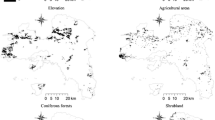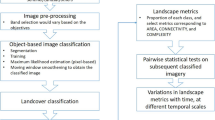Abstract
The data set of a human modified Dutch landscape was used to evaluate whether landscape pattern indices developed in the United States are fit to describe a Dutch landscape. The grid based data set contains the development of land use over the period 1845–1982. The indices were divided in two groups: pattern indices and change indices. In the first group the proportion of each land use type (P), patch number (N), mean patch size (A) and two indices of patch shape (S1 and S2) were tested; in the second group the rate of change (C) was tested.
Not all indices considered in this case study are suitable for the Dutch landscape. The dominance index (D) seems not to be sensitive enough to respond in a clear way to changes in the landscape studied. Shape index seems to be a complicated index, particularly in a human modified landscape like the Dutch, where the shape of natural patches is fixed by their man-made neighbours. The trends observed in the two shape indices considered in this study are not satisfactory since each index considers another aspects of shape (either the interior-to-edge ratio or the complexity of the patch perimeter).
None of the indices appears to give information on changes in the geographical position of the patches, which implies that nothing can be induced with respect to the real landscape dynamics.
The indices have to be considered in combination to produce meaningful information. The combination of proportion of each land use (P) and the data of the transitions shows how the development in land use has been. Number of patches (N) together with the mean size of patches (A) gives a good indication of the pattern development.
Further research is necessary to develop a useful method how to quantify the change in landscape pattern and to give an ecological meaning to the index value in relation to the process of changing pattern.
Similar content being viewed by others
References
Burgess, R.L. and Sharpe, D.M. (eds.) 1981. Forest island dynamics in man dominated landscapes. Springer-Verlag, New York.
Davis, J.C. 1986. Statistics and data analysis in geology. John Wiley & Sons, New York.
Fahrig, L. and Merriam, G. 1985. Habitat patch connectivity and population survival. Ecology 66: 1762–1768.
Fanta, J. 1986. Primary forest succession on blown-out areas in the Dutch drift-sands. In Forest Dynamics Research in Western and Central Europe, pp. 164–169. Edited by J. Fanta. Pudoc, Wageningen.
Franklin, J.F. and Forman, R.T.T. 1987. Creating landscape patterns by forest cutting: ecological consequences and principles. Landscape Ecology 1: 5–18.
Freemark, K.E. and Merriam, H.G. 1986. Importance of area and habitat heterogeneity to bird assemblages in temperate forest fragments. Biol. Conserv. 36: 115–141.
Forman, R.T.T. and Godron, M. 1986. Landscape Ecology. John Wiley & Sons, New York.
Harms, W.B. and Opdam, P. 1990. Woods as habitat patches for birds: application in landscape planning in The Netherlands. In Changing Landscapes: An Ecological Perspective, pp. 73–97. Edited by I.S. Zonneveld and R.T.T. Forman. Springer-Verlag.
Howe, R.W. 1984. Local dynamics of bird assemblages in Australia and North America. Ecology 65(5): 1585–1601.
Iverson, L.R. 1988. Land-use change in Illinois, USA: The influence of landscape attributes on current and historic land use. Landscape Ecology 2: 45–61.
Koster, E.A. 1978. De stuifzanden van de Veluwe: een fysisch geografische Studie. Thesis, University of Amsterdam.
Krummel, J.R., Gardner, R.H., Sugihara, G., O'Neill, R.V. and Coleman, P.R. 1987. Landscape patterns in a disturbed environment. Oikos 48: 321–324.
Lamb, H.H. 1984. Climate in the last thousands years: Natural climatic fluctuations and change. In The Climate of Europe: Past, Present and Future, pp. 25–64. Edited by H. Flohn and R. Fantechi. Reidel Publishing Company, Dordrecht.
O'Neill, R.V., Krummel, J.R., Gardner, R.H., Sugihara, G., Jackson, B., DeAngelis, D.L., Milne, B.T., Turner, M.G., Zygmunt, B., Christensen, S.W., Dale, V.H. and Graham, R.L. 1988. Indices of landscape pattern. Landscape Ecology 1: 153–162.
Opdam, P. 1987. De metapopulatie: model van een populatie in een versnipperd landschap. Landschap 4: 289–306.
Ouborg, N.J. 1988. Genetische verarming: de problematiek van het beheer van kleine populaties. De Levende Natuur 1: 7–13.
Pape, J.C. 1970. Plaggen soils in the Netherlands. Geoderma 4: 229–255.
Rafferty, J., Norling, R., Tamaru, R., McMath, C. and Morganstein, D. 1985. Statworks, statistics with graphics for the MacIntosh. Heyden and Son, London.
Ryszkowski, L. and Kedziora, A. 1987. Impact of agricultural landscape structure on energy flow and water cycling. Landscape Ecology 1: 85–94.
Sharpe, D.M., Stearns, F., Burgess, R.L. and Johnson, W.C. 1982. Spacio-temporal patterns of forest ecosystems in man-dominated landscapes of eastern United States. In Perspectives in Landscape Ecology, pp. 109–116. Edited by S.P. Tjallingii and A.A. de Veer. Pudoc, Wageningen.
Turner, M.G. (ed.) 1987a. Landscape heterogeneity and disturbance. Springer-Verlag, New York.
Turner, M.G. (ed.) 1987c. Spatial simulation of landscape changes in Georgia: a comparison of 3 transition models. Landscape Ecology 1: 29–36.
Turner, M.G. 1990. Spatial and temporal analysis of landscape patterns. Landscape Ecology 4: 21–30.
Turner, M.G. and Ruscher, C.L. 1988. Changes in the special patterns of land use in Georgia. Landscape Ecology 1: 241–251.
Van den Berg, A., Lentjes, P.G., Van Lith, J. and Roos, J. 1985. Handleiding van MAP2 versie 1.0. De Dorschkamp, Wageningen.
Van Dorp, D. and Opdam, P.F.M. 1987. Effects of patch size, isolation and regional abundance on forest bird communities. Landscape Ecology 1: 59–73.
Vervloet, J.A.J. 1977. Cultuurhistorie. In Rapport van het Veluwe-onderzoek. pp. 67–80. Edited by S.M. ten Houte de Lange. Pudoc, Wageningen.
Webster, R. 1977. Quantitative and numerical methods for soil survey and classification. Oxford University Press, Oxford.
Author information
Authors and Affiliations
Rights and permissions
About this article
Cite this article
Hulshoff, R.M. Landscape indices describing a Dutch landscape. Landscape Ecol 10, 101–111 (1995). https://doi.org/10.1007/BF00153827
Issue Date:
DOI: https://doi.org/10.1007/BF00153827




